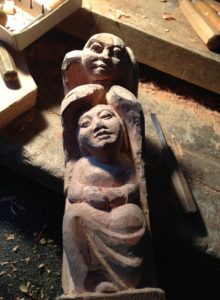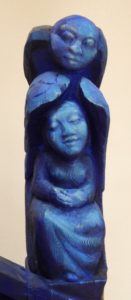Japanese art has been a big influence on my aesthetic and choice of wood as my primary medium. This August, I will be attending the Inami International Wooden Sculpture Camp in Nanto City, Japan. It will be held at Zuisen-ji, the largest temple in the Hokuriku region, built-in 1390. The vicinity is the workplace of 200 woodcarvers, one of the world’s largest woodcarving centers.
Each invited sculptor is given a 6-foot log and 10 days to complete the artwork. The finished art becomes part of Nanto City’s Public Art Program. The theme of the carving camp is “To Bring the World Together through Wooden Sculpture.” It’s a mix of international sculptors and traditionally trained Japanese artists all working on the temple grounds. The public is welcome on-site to watch the progress. In fact, it is a great opportunity to witness the camp to celebrate both the long tradition of wooden sculpture and help advance this art into the 21st Century.
Meeting the Broader Wooden Sculpture Community
The opportunity to meet sculptors from all over the world, and to have a focus on the wooden sculpture is a rare experience for everyone to learn new techniques and exchange ideas. It is a positive environment to understand at a deeper level this ancient art we practice. While the event is not a competition, carving a 6-foot log in ten days will be a personal challenge of planning, skill, and stamina. Japan in August is hot and humid.
On the registration form, they requested both an image and the meaning of the work I intended to make. I had an idea inspired by a famous poem by Matsuo Basho for very Japanese flavor artwork. Rereading the directions carefully, I found the stipulation that it reflects “your culture.” That made me pause: “What is my culture?” After a lot of thinking, I decided if they want my culture: Western, Christian, Catholic, I would carve “Listening to the Moon.” A young woman and the moon as an angel, an Annciation. First carved as a small detail of a large sculpture, this is the opportunity to enlarge it. All the finished carvings become part of the public art collection of Nanto City.
To learn more about Patrick’s work, Pacific Northwest Sculptors, or, contact us today!


Leave a Reply
You must be logged in to post a comment.